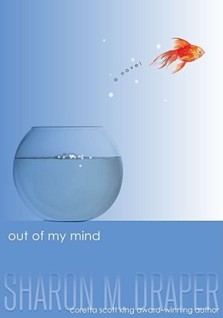A classroom read aloud can be an electrifying experience for students… or utter torture.

For my daughter, it was the later when she was in 6th grade. The Ear, Eye, and Arm by Nancy Farmer was the read aloud in her Language Arts classroom that dragged across three months, essentially strangling the life out of any pleasure to be gained from the experience.
Lately, I’ve been reflecting about class read alouds, particularly novels. It started when over the course of one week, two of my colleagues came to my classroom to borrow books: Out Of My Mind by Sharon Draper and The Giver by Lois Lowry. Of course, I was thrilled to loan them these fantastic reads. But I was puzzled. One of my colleagues is an 8th grade science teacher, and the other teaches 8th grade algebra. They explained that these books were not for their classes, but instead for their own children. Both teachers had the same problem: Their child’s classroom teacher was stretching a class read aloud across several months and their children were dying to keep reading! Their children were so frustrated by how long it was taking to finish the class read aloud that they begged their mothers to get them their own copy!
I have to admit. When I first started teaching, I was THAT teacher. The one who maybe read “a chapter a day” which meant a class read aloud could take multiple weeks. The one who thought reading instruction was about “teaching books.” “I teach The Watson’s Go To Birmingham, 1963,” I might have said to a colleague.
I’m happy to report that I am a reformed read-alouder who understands that stretching a book out across a lengthy amount of time sucks the joy out of reading for students. We may have the best intentions in mind: to share a wonderful story with our students. But let’s just think about it. We select a fantastic book. We’ve got our students right where we want them: on the edges of their seats ready to devour this great story. And then, we rob them from the excitement of the story by dragging it out across weeks or months????
Here are a few things to consider about a read aloud:
- Teach reading, not “a book.” There are so many wonderful books to introduce to and share with our students. But we are teachers of reading and our students need to develop strategies and skills that go far beyond any one book or story. One of the most important strategies we want to teach our students is how to fall deeply in love with reading. Shouldn’t this be our number one priority with a read aloud?
- Select one or two strategies to teach and one or two skills to practice. Perhaps it’s a genre specific strategy so that students understand the unique elements of a genre and can apply this to their independent reading. Or maybe you want to help students strengthen their predicting skills. Think about which strategies and skills can be spotlighted with a particular read aloud.
- Finish the read aloud in a week…two at the most! Yes, this will require setting aside time to accomplish this, but it’s worth it! Our students need to know that reading too slowly, not just reading too quickly, can compromise comprehension. When so much time passes, the specific details can slip away from our memories. Read alouds should happen frequently across the year in the classroom. Therefore, we don’t need to put all of our “eggs” into any one book as if it will be the only opportunity for a shared reading experience. Multiple read alouds, whether they are chapter books, picture books, digital texts, articles, or poems means multiple opportunities to teach reading strategies and to bolster the skills students need to become accomplished readers.
The excitement students have during a read aloud they love is precious and powerful; it’s like catching lightning in a bottle. When teachers capture this it can be used to demonstrate the electrifying experience of reading.
Sonja Cherry-Paul loves reading aloud to her 6th graders. Nothing is better than hearing the chorus of “No! Please read more! Don’t stop! she gets when she tells her class it’s time to go. Sonja is a member of the Jane Addams Children’s Book Award Committee. She has been immersed in reading wonderful books created by authors and illustrators who address themes related to social justice. The best part of this process is sharing these incredible books with her 6th graders and the insightful conversations they spark. She is co-author of Teaching Interpretation: Using Text-Based Evidence to Construct Meaning and Flip Your Writing Workshop: A Blended Learning Approach.



